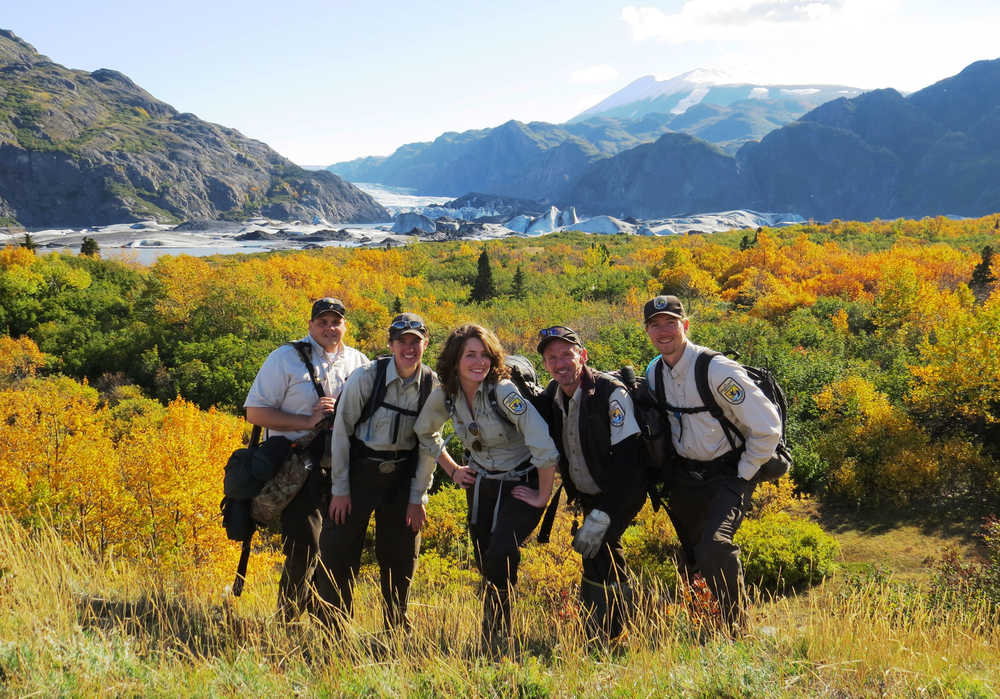As I traverse through my daily mountains of permits, paper work, and visitor requests, there is never doubt in my mind that my days in the office at the Kenai National Wildlife Refuge will always be an adventure. This is one of the reasons I truly enjoy my administrative position here at the Refuge — there is seldom time for boredom.
Still, every now and then, I start to think maybe the grass is greener on the other side. I feel this especially on those beautiful Alaskan summer days when I’m stuck inside and the trail crew stops by the office with sun and dirt on their faces. So, when the opportunity arose for me to get out on the 73,000-acre Tustumena Lake with the trail crew, I jumped at it.
After hitting most of the popular Refuge trails all summer long, our trail crew had a little time for a special project resurrecting the old Tustumena Glacier Trail at the far eastern end of the lake. The trail gets grown over from time to time, so we were there to make it more passable for hikers and hunters. Overall, the mile-long hike was relatively flat which makes for easy walking, although hip boots are needed for about 100 yards due to overflow from glacial melt.
Except for a few inholdings, this enormous 23-mile long lake is entirely within Congressionally-designated Kenai Wilderness. Did you know that Tustumena Lake has a maximum depth of almost 1,000 feet? That’s deeper than the Cook Inlet!
I can’t deny the excitement wore off a little when I’m told I have to put the camera down and actually use the pulaski I carried in! At one point I remember thinking to myself — as I’m covered in sweat, dirt, no-see-ums, and confused about which end of the tool I should be using — that I’m happy spending most of my days at the Refuge Visitor Center. It was a real eye opener for me to see how hard trail and cabin crews work.
When on Tustumena Lake you have a sense of being somewhere very remote. As we hike to the glacier, someone mentions that they feel as if they aren’t on the Kenai Peninsula anymore. I feel the same way, because having never seen it before (despite growing up here), it was uncharted land to me. It was a great feeling, and some might say selfish too, as I knew I was seeing something that most people will never see in their lives. Tustumena seems to be a perfect balance of accessibility and wilderness that makes it this way for visitors such as myself.
In order to get to Tustumena, one must either take a boat that’s big enough to handle a lake of that size, a floatplane, a horse, or take a long hike. Obviously, not everybody has these methods of transportation available to them or the ambition to hike the seven miles of the Pollard Horse Trail to just get to the western shore line.
That late September day on Tustumena Lake was about as perfect as a day on the eighth largest lake in Alaska could be. The combination of the fall colors, a hike to Tustumena Glacier, and the glass-like water conditions made for an unforgettable day. I’ve heard many stories of how unpredictable the conditions of that lake can be, so I know I was lucky to have a day in which my biggest challenge was staying awake on the smooth boat ride back. The physical labor on the trail really wore me out.
We also checked in on a few of our historic pubic use cabins on Caribou Island and at Big Bay. Both cabins are in great locations, and feel like a true wilderness getaway. Big Bay Cabin, built in the 1890’s, is now one of the oldest standing structures on the Kenai Peninsula.
I recall from an end-of- the-summer Refuge staff meeting that almost all of Youth Conservation Corps kids (all local residents) said that visiting Tustumena Lake was the best part of their experience on the Refuge. Many of them also realized that chances are they would have never seen it if they hadn’t applied for their job. What a great thing to be able to say…
Donna Handley is an administrative assistant at the Kenai National Wildlife Refuge. You can find more information about the refuge at http://kenai.fws.gov or http://www.facebook.com/kenainationalwildliferefuge.

